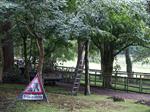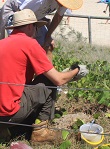 Study tree management, tree planting, improving tree health, tree selection techniques and more.
Study tree management, tree planting, improving tree health, tree selection techniques and more.
This course concentrates on tree planting and maintenance.
CONTENT
There are 7 lessons as follows:
1. Planting Techniques
Soil, Water, Climate, Maintenance, Matching a tree to the site, Local regulations, Plant at the right time, Planting techniques, Plant size and age, Container type, Buying a tree, How to plant a tree, Watering method, Transplanting a large tree, Preparing for transplanting, Aftercare, small feature trees, Transplanting deciduous trees, Pruning at planting, Pocket planting, Slope serration, Wattling, Planting on Arid sites, Direct seeding, Spray seeding, trees with berries.
2. Controlling Plant Problems
Temperature, Frost, Winds, Acclimatisation, Tree guards, Other Tree Problems (Fire damage, Fire Resistant trees, pollution and toxic reactions, Soil contamination, Treating foliage burn, Soil rehabilitation, Trees to extract soil contaminants, Soil chemical composition, Air pollution and tree growth, pollutant tolerant trees, Pollution intolerant trees, Trees to control Urban air pollution, Dry soils, Symptoms of drought stressed trees, Dry soil tolerant trees, Trees for hot sites, Drainage problems and trees, Wet tolerant trees, Treee health problems, Resistant plant species, Choosing and using pesticides safely, Biological controls of pest and disease, Life cycles, Tree termites, Tree injections, Tree nutrition and nutrition management, Fertilisers
3. Strengthening Weak Trees
Trimming, Trimming technique, Adverse responses to trimming, thinning, Bracing, temporary props, Modern bracing systems, Bolting, Rodding technique, Guy wires, How strong is dead wood, Cabling.
4. Controlling Damage Caused by Plants
Tree damage, Tree root problems, trees that can cause problems with drains, Precautions with drains, Selecting and using trees near drains, Limiting root problems, Root pruning, Trees and the water table (Aquafiers), Trees and power lines, Poisonous trees,
5. Tree Felling and Stump Removal
Tree evaluation systems, Calculating tree value, Tree removal, Why remove a tree, Tree felling methods, Axe, Saws, Winches, Chain saw, Controlling the fall, Different methods or removing stumps, Protecting trees, National Tree registers, Measuring tree height, Keeping a work site safe, risk assessment, Duty of care, Costing jobs,
6. Tolerant Plant Species
What to plant where, Tree data required, Influence of trees on buildings, Species suitability, Planning considerations, Harsh environments, frost protection, Frost resistant trees, Sun protection, Mulching, Fencing, wind protection, Wind tolerant trees, Soil degradation, Saline tolerant trees, Lime tolerance, Acid tolerance, Hardy trees for inner city, Review of several major genera (Aer, Fraxinus, Pinus, Quercus,
7. Establishing a Tree Plantation
Windbreaks, Windbreak design, Choosing windbreak species, Designing tree plantations, Producing drawings to scale.
Duration: 100 hours
COURSE AIMS:
- Explain how to plant a specified advanced-sized tree on a specific site.
- Explain tree injection, including the technique and applications.
- Identify situations where trees require strengthening operations to be carried out.
- Compare different ways to control roots which invade underground pipes.
- Calculate the cost of removing a specified tree.
- Determine five appropriate tree species suited to a specific site visited and analysed.
- Devise a method for removing a tree, including tree felling and stump removal.
- Analyse specimens of mature trees, from each of five different genera, to detect any patterns in problems occurring in those trees.
- Develop criteria for the establishment of a tree plantation on a specific site which addresses; site restrictions, cost and function
 Tips -Innovative Ways to Plant Trees
Tips -Innovative Ways to Plant Trees
Pocket Planting
This is simply establishing a pocket or basin on a slope, with the soil excavated from the pocket being used to form a wall enclosing the pocket, particularly on the downslope side. The wall will then retain water and help prevent soil erosion occurring. An overflow spillway in the wall will prevent the pocket from being washed away in heavy rains. The pocket may need to be reformed every now and then, until the plant is established.
Slope Serration
Sloping sites can be terraced to enable plant establishment and reduce erosion. Slopes are cut into steps which measure approx. 1 m x 1 m, with the steps sloping back towards the hill to retain water. Over time, the steps will erode, however, the plants will usually have become established by then. The loose soil from the eroded steps also provides favourable germination sites for seed which is dropped from other nearby plants.
Wattling
This technique relies on the use of bunches of branches placed on slopes to prevent erosion. Bundles of long, slender branches are tied into bundles and are partially buried in contoured trenches which have been cut across the slope, or cut branches and dried brush are simply spread across the surface of the slope.
In some cases, the wattling bundles have been prepared from species which root easily (eg. willows or poplars) and which then become part of the slope stabilisation scheme. Dried brush is sometimes used as an alternative, especially in countries where introduced willows or other suckering plants are likely to become invasive weeds.
Planting Arid Sites
Plant establishment in unirrigated, arid sites can be extremely difficult. Mulching, controlling competing weed growth, wide spacing of plants and creating saucers of soil to retain water, are simple ways of overcoming the water shortage problem. Smaller-sized plants also have a better chance of becoming established.
Condensation traps have also been used with some success in areas with clear night skies. One simple method of trapping the moisture from condensation is to construct a 1.5 m diameter planting basin with a depth of 30 cm. The plant is placed on a mound in the centre and polythene sheeting is arranged to absorb evaporating soil moisture.
Direct Seeding
Direct seeding is a low cost method of re-establishing vegetation, although the results are less predictable than transplanting established nursery- grown plants.
The most important factor is to eliminate weed growth before seeding to remove competition from the germinating seeds. An initial spray with chemical herbicides will give the best results; alternatively cultivation can be used to encourage dormant weed seeds to germinate which can then be sprayed. A light cultivation of the soil will also provide favourable germination conditions for the seed. Seed can then be broadcast either by hand on small sites, or by direct drilling or mechanical hoppers for larger areas. Fencing the site and follow-up weed control is also be required.
In areas where there is an existing cover of native vegetation, natural regeneration can give good results. The site should be fenced off, and the weeds on the windward side of the tree (where seeds are most likely to drop) should be removed.
Spray Seeding
Spray seeding is a technique which is often used on sites which are steeply sloped or have limited access. Seeds are mixed into a slurry of water and wood cellulose materials (ie. paper, wood shavings, sawdust etc). Using a pump, the mixture is then sprayed onto the surface of the ground. The slurry acts to provide a protective mulching surface for the seeds.
Why You Should Study This Course
This course adds to knowledge gained in our Arboriculture I module but may be studied as a stand-alone course by those with previous studies or experience in tree surgery. The focus here is more on using trees in the landscape and dealing with problems caused by environmental factors. Students will learn how to make suitable tree choices and how to successfully grow trees. This course is particularly suited to people working in the following areas:
Tree surgery
Arboriculture
Tree nursery
Parks & gardens
Garden maintenance
Garden or landscape rehabilitation
General horticulture
WHAT NEXT?
Register to Study - Go to panel toward top of this page (right column)
or
Get Advice - Use our FREE COUNSELLING SERVICE to contact a tutor
CLICK TO CONTACT US